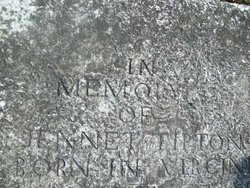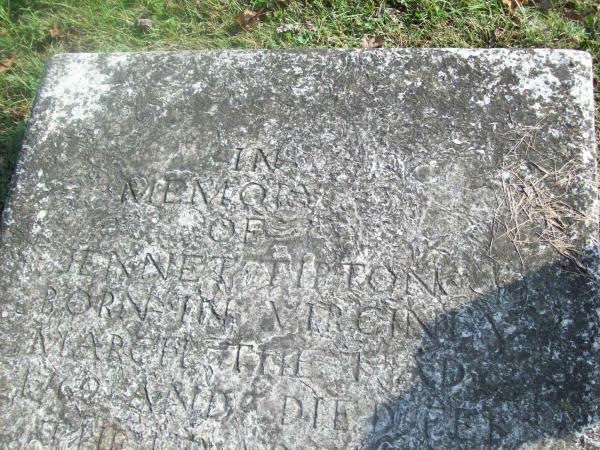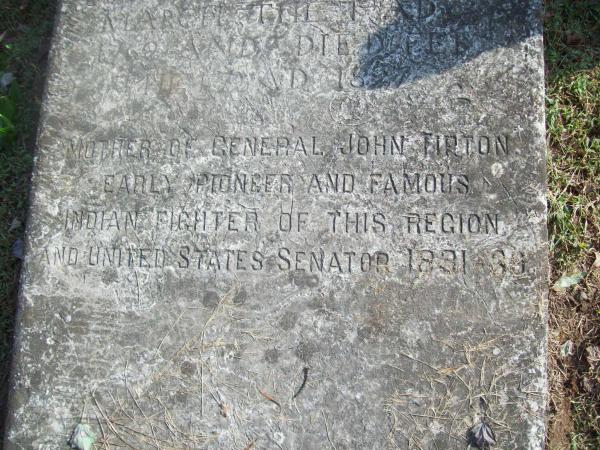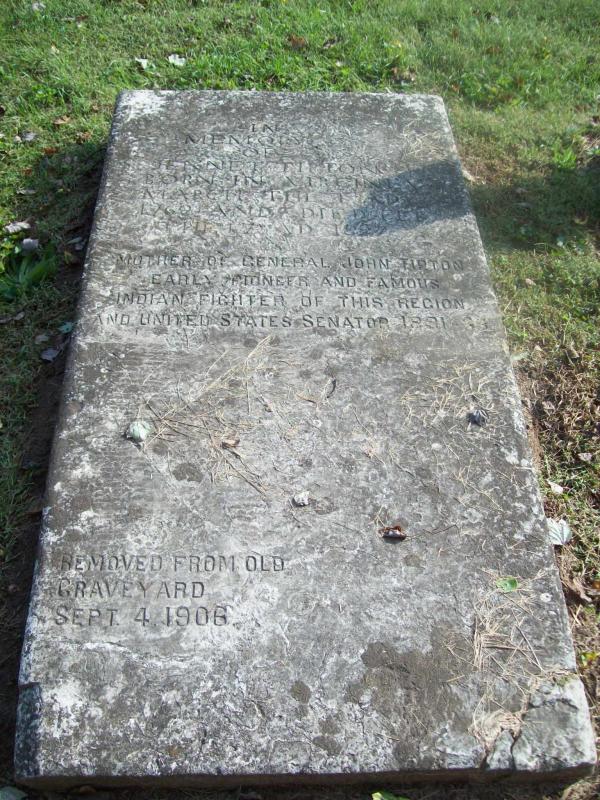Wife of Joshua Tipton. Somewhere along the waters of the East Fork of the Little Pigeon where he was killed by the Indians or near the site of Shields Fort where he lived, is the unmarked grave of Joshua Tipton, Revolutionary War Solider.
Trigger warning: biographies are taken verbatim from a family history book with uncensored original language. (Words in brackets are added for clarity.)
JANET [or JENNET] SHIELDS, the only daughter [of the Shields family of "Ten Brothers"], was born Mar. 7, 1762. She married Joshua Tipton in 1785. He was a son of the elder General John Tipton who was very prominent in the early history of Tennessee. Janet had five children, the four whose names are known being Rhoda, John, Agnes, and Elizabeth. Joshua was ambuscaded and killed by Cherokee Indians Apr. 18, 1793. In 1808 Janet and her family migrated to Indiana, settling at Shields Fort, the present location of Seymour. To her son, John Tipton, Indiana owes more of its early history than to any other man who ever lived in the State.* His impress upon the history of Indiana as a whole and particularly upon Columbus, Ft. Wayne, Logansport and Indianapolis will never be removed. He served with distinction as a General in the U.S.Army, as U.S.Commissioner of Indian Affairs, and as U.S.Senator. He was Grand Master of the Masonic Lodges of the Northwest Territory. Janet died Feb. 17, 1827 and is buried in Riverview Cemetery, at Seymour, Indiana.
* His full name was John Shields Tipton. Though only seven years old when his father was killed by Indians, the impression that tragedy made was lasting. He was an implacable "Indian hater" all his life. On coming to Indiana with his mother and three young sisters in 1808, he lived a while at his Uncle James Shields' Fort (now Seymour), but soon joined the Army under General Harrison. He participated in putting down many Indian uprisings before and after the War of 1812, in which he served, his most important engagement being the Battle of Tippecanoe. He moved his headquarters to Corydon where he had a prominent part in the organization of the State of Indiana. He was on the Committee that selected the site of Indianapolis for the State Capital and, being a surveyor, he platted that city in its distinctive axial form. He was Indiana's representative on the Commission that fixed the Indiana-Illinois boundary. It was he who moved the Pottawatomie Indians from Michigan, Indiana and Illinois to the Reservation that was located in what is now Jackson County, Kansas.
From "Three Kansas Pioneer Families: Stalker-Shields-Martin" by John A. Shields, privately published in a limited edition of 200 copies, May, 1949.
Wife of Joshua Tipton. Somewhere along the waters of the East Fork of the Little Pigeon where he was killed by the Indians or near the site of Shields Fort where he lived, is the unmarked grave of Joshua Tipton, Revolutionary War Solider.
Trigger warning: biographies are taken verbatim from a family history book with uncensored original language. (Words in brackets are added for clarity.)
JANET [or JENNET] SHIELDS, the only daughter [of the Shields family of "Ten Brothers"], was born Mar. 7, 1762. She married Joshua Tipton in 1785. He was a son of the elder General John Tipton who was very prominent in the early history of Tennessee. Janet had five children, the four whose names are known being Rhoda, John, Agnes, and Elizabeth. Joshua was ambuscaded and killed by Cherokee Indians Apr. 18, 1793. In 1808 Janet and her family migrated to Indiana, settling at Shields Fort, the present location of Seymour. To her son, John Tipton, Indiana owes more of its early history than to any other man who ever lived in the State.* His impress upon the history of Indiana as a whole and particularly upon Columbus, Ft. Wayne, Logansport and Indianapolis will never be removed. He served with distinction as a General in the U.S.Army, as U.S.Commissioner of Indian Affairs, and as U.S.Senator. He was Grand Master of the Masonic Lodges of the Northwest Territory. Janet died Feb. 17, 1827 and is buried in Riverview Cemetery, at Seymour, Indiana.
* His full name was John Shields Tipton. Though only seven years old when his father was killed by Indians, the impression that tragedy made was lasting. He was an implacable "Indian hater" all his life. On coming to Indiana with his mother and three young sisters in 1808, he lived a while at his Uncle James Shields' Fort (now Seymour), but soon joined the Army under General Harrison. He participated in putting down many Indian uprisings before and after the War of 1812, in which he served, his most important engagement being the Battle of Tippecanoe. He moved his headquarters to Corydon where he had a prominent part in the organization of the State of Indiana. He was on the Committee that selected the site of Indianapolis for the State Capital and, being a surveyor, he platted that city in its distinctive axial form. He was Indiana's representative on the Commission that fixed the Indiana-Illinois boundary. It was he who moved the Pottawatomie Indians from Michigan, Indiana and Illinois to the Reservation that was located in what is now Jackson County, Kansas.
From "Three Kansas Pioneer Families: Stalker-Shields-Martin" by John A. Shields, privately published in a limited edition of 200 copies, May, 1949.
Family Members
Advertisement
Advertisement

















